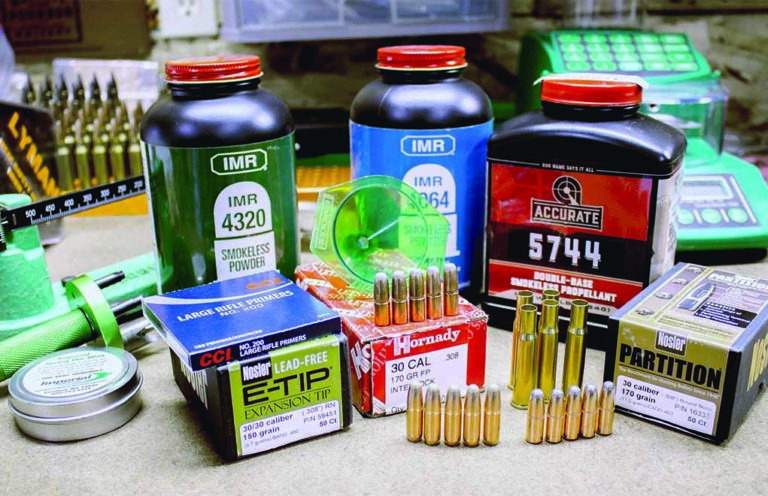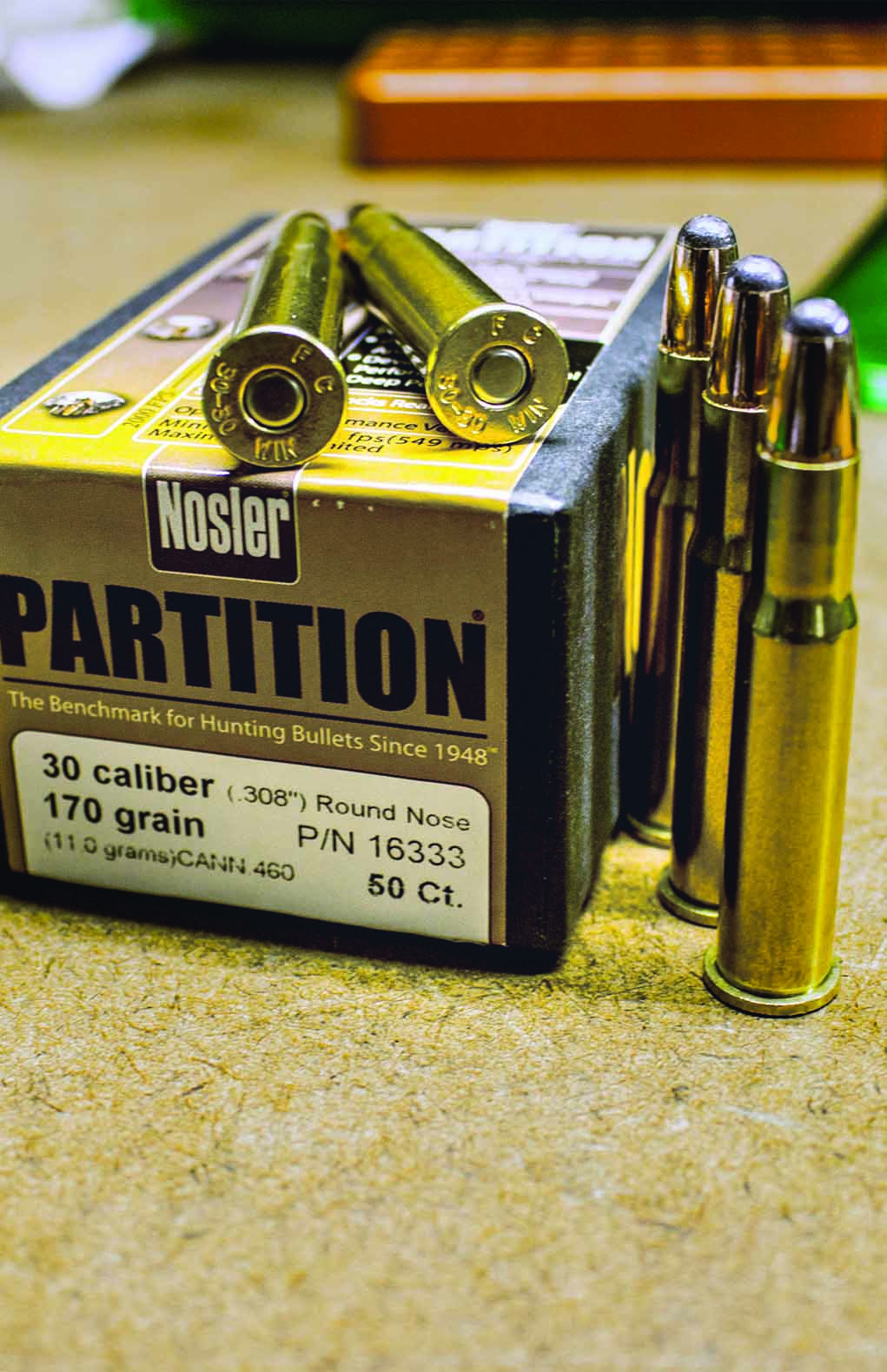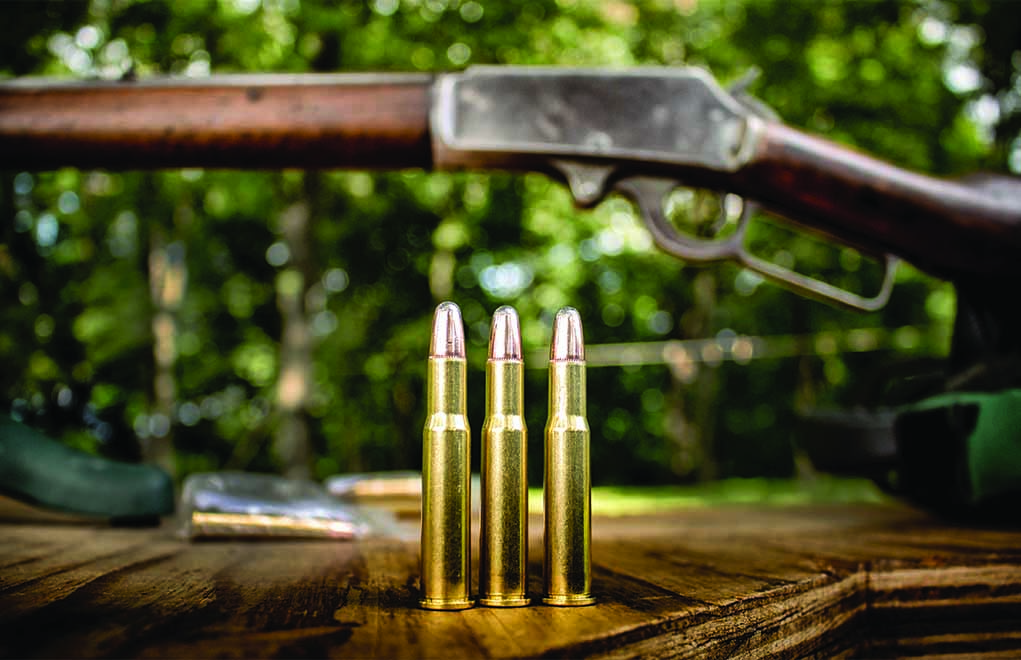
Fall in love with the 125-year-old .30-30 Winchester all over again, this time on the reloading bench.
Does anyone shoot a .30-30 anymore? I mean, it doesn’t say “Creedmoor,” it doesn’t launch bullets with a BC of .900, and it sure won’t take an elk at 700 yards.
However, the resounding answer is, Hell, yeah! It still makes an excellent close-quarters rifle for deer, black bear, feral hogs and more. It’s very easy to shoot, it usually comes in a slim, svelte rifle that’s easy to carry, and it handles well in the thick woods.
Is it sexy? Certainly not by modern standards, but there’s absolutely no arguing the effectiveness of the cartridge in the hands of a hunter who knows how to get within 100 or so yards of their quarry.
Like my father, I took my first whitetail with a .30-30. I had a Winchester Model 94, and my father had a Marlin Model 1893. It was affordable to shoot (to this day, a decent box of ammo can be had for under $20), and while I’ve had many rifles since, I can honestly say that I’ve had more misfires with factory .30-30 ammunition than probably all others combined. Across the multitude of Marlins, Savages, H&Rs and Winchesters, it seemed as if the 1980s and ’90s were eras of lousy .30-30 ammunition.
However, it did have an upside: It drove me to learn how to handload my own ammunition.
The .30-30 Backstory
With a big rim for positive headspacing and a neck long enough for good neck tension, the .30-30 Winchester isn’t at all hard to handload. Historically, it has the honor of being the first American small-bore cartridge designed around smokeless powder, and it’s simply a .38-55 Winchester case necked down to hold .308-inch-diameter bullets.

At the time, our beloved .30-caliber was not anywhere as popular as it currently is (.32-caliber was actually more popular in the late 1890s), but as the .30-30 Winchester, along with the .30-40 Krag, it was about to change all that. The John M. Browning-designed Model 1894 Winchester would be the major vehicle to bring the cartridge to the masses, going on to sell more than 7,000,000 units—with the majority in .30-30 Winchester.
The very name of the cartridge hints at the proper powder charge; while using the black powder-era nomenclature, the latter number in the name is actually the smokeless powder charge. (My own favorite loads weigh at or near 30 grains … but more about that in a minute.)
Like so many of the rimmed, lever-action cartridges of that era, the .30-30 Winchester has a rather thin case. While this doesn’t pose an issue if pressures and velocities are kept in check, when a reloader tries to push the envelope, the case will often fail prematurely, usually in the form of cracked necks. In some lever guns, excess pressure could manifest itself in the form of primers popping out of the pocket slightly.
Barrel Lengths & Velocities
I’ll say this straight-faced: Trying to turn the .30-30 Winchester into the .300 Savage or .308 Winchester is no good for you or your rifle, but if you accept the parameters of the cartridge, you’ll have a lifetime of great shooting. The factory ammunition for the .30-30 lists the 170-grain load at roughly 2,200 fps and the 150-grain load at 2,400 fps. Those numbers are usually spot-on in the longer-barreled rifles, but no so much in the carbines.

For example, my Winchester Model 94 AE XTR is a light and handy rifle, but its 20-inch barrel gives velocities about 150 fps lower than the advertised values. My dad’s 1902-vintage Marlin Model 1893 (with its 26-inch barrel) gives muzzle velocities much closer to those listed on the box.
Does that mean my rifle is ineffective? No, but it does affect the trajectory out past 100 yards, and I’m not comfortable shooting iron sights much farther than that anyhow.
So, when reloading for the .30-30, plan to see velocities commensurate to your barrel length. Handloaded ammunition for the .30-30 will generally run about 50 fps behind factory ammunition, and then, you should adjust for your barrel length—about 25 to 30 fps for each inch of deviation from the test barrel—adding speed if your barrel is longer and subtracting if it’s shorter.
Best .30-30 Winchester Loads
The most accurate load in my Winchester 94 uses a 170-grain Hornady InterLock round-nose bullet over 30.0 grains of IMR4064, sparked by a CCI 200 primer, with a muzzle velocity of 2,025 fps. It’ll print three in an inch at 50 yards, and just over 2 inches at 100. At 170 grains, the Hornady Interlock has enough sectional density to give good penetration on both deer and bear.
Load Up On Reloading Info:
- The Flexible And Forgiving .30-06 Springfield
- The .45 Colt: A Wheelgun Classic
- .300 Win. Mag.: The Answer To Most Hunting Questions
- Tips For Reloading the .223 Remington
I also like the 170-grain Nosler Partition—with a good round-nose design so there’s no issue in a tubular magazine—over 31.2 grains of IMR4320 in the longer-barreled Marlin, giving 2,190 fps. The same bullet is equally accurate with 27.0 grains of Norma 200 powder (while not nearly as popular as the IMR, Hodgdon and Alliant powders, the Norma series is excellent stuff). Be sure to check the barrel length on the test data, and if your barrel is longer, it’s most important to start at the bottom of the scale and work upward.
If you live in a lead-free zone or prefer the performance of a monometal bullet, the 150-grain Nosler E-Tip, with a round, polymer tip and boat-tail (for ease of loading), makes a great choice. That Marlin 1893 likes a charge of 31.5 grains of IMR4895 for 2,415 fps.
I like to seat my bullets to the middle of the cannelure, and I set my seating die up for a good roll crimp. Both these rifles use a side-loading gate and a tubular magazine, and the nose of the bullet will be used to push the previous cartridge farther into the tube magazine; even with the .30-30’s good neck tension, the bullet can be pushed into the case without a good crimp.
A standard large rifle primer (I lean heavily on the Federal 210 and the CCI 200) will work just fine for the .30-30 case, because the capacity usually runs between 34 and 36 grains, depending on brand and bullet seating depth. For powder choices, the .30-30 likes medium-burning choices such as IMR4064, IMR4320, Varget, Reloder 15 and IMR4895. I’ve had good results with Norma 200 and Accurate 5744 as well.
For lever rifles, I highly recommend full-length resizing all your cases, because the rifles don’t have the power to cam the action closed like a bolt rifle does. Keep things consistent, and I bet you’ll fall in love with the 125-year-old cartridge all over again.
The article originally appeared in the November 2019 issue of Gun Digest the Magazine.
Purchase The Components Used In This Article:
- Hornady InterLock Bullets starting at $27.99 Cabela's
- IMR 4064 Smokeless Powder $33.99 at Cabela's
- CCI Standard Primers $4.49 at Cabela's
- Nosler Partition Bullets starting at $29.99 Cabela's
- Norma 200 Powder $32.49 at Natchez
- Nosler E-Tip Bullets starting at $24.99 at Brownells
- IMR 4895 Powder $29.49 at Natchez
- Federal 210 Large Rifle Primers $2.99 at Sportsman's Warehouse
- IMR 4064 Powder $29.49 at Natchez
- Hodgdon Varget Powder $30.99 at Natchez
- Reloader 15 Powder $27.99 at Brownells

Next Step: Get your FREE Printable Target Pack
Enhance your shooting precision with our 62 MOA Targets, perfect for rifles and handguns. Crafted in collaboration with Storm Tactical for accuracy and versatility.
Subscribe to the Gun Digest email newsletter and get your downloadable target pack sent straight to your inbox. Stay updated with the latest firearms info in the industry.

![Best Concealed Carry Guns In 2025 [Field Tested] Wilson Combat EDC X9S 1](https://gundigest.com/wp-content/uploads/Wilson-Combat-EDC-X9S-1-324x160.jpg)


![Best 9mm Carbine: Affordable PCCs [Tested] Ruger Carbine Shooting](https://gundigest.com/wp-content/uploads/Ruger-Carbine-Shooting-100x70.jpg)
![Best AR-15: Top Options Available Today [Field Tested] Harrington and Richardson PSA XM177E2 feature](https://gundigest.com/wp-content/uploads/Harrington-and-Richardson-PSA-XM177E2-feature-100x70.jpg)

You would serve readers better with the knowledge that primers do protrude out of the case after being fired from lever guns. The pressure does move the primer out and is a way to measure the head space on a lever gun. This however is not an indication of over pressure as you indicated in the article.
I got two 30-30s and considering owning a third. It’s fun to shoot and will take most game at close range.
I killed my first deer with a henry 30 30 it was a spike at 15 yards. SUB TO WOLF LAKE HUNTER NOW
I handload for my 30-30 Model 94 Winchester built in 1952. I’ve been using a LEE Loader kit forever and have never had any issues with misfires. Since the loader only neck sizes the brass, this being said, I test fit all brass through the gun after sizing and before loading to ensure function. Its favorite load is a Barnes-X (30-30) 150 grain hollow-point (opening looks like an oil drum) over 33.7 grins (2.2cc) of Hodgden LEVERevolution powder, lit by a Winchester large rifle primer. This gives 2215 fps and will print right at 1-inch groups at 100 yards. Very mild and hits with authority.
P.S. The LEE kit will also load the .30 Remington (a rimless version of the 30-30)
I’ve only recently began Reloading for the .30 WCF or 30-30 (your preference), as I only inherited this Model 1894 (mfg. date 1952). So, I’ve really only begun to find a load that will work best in the gun.
Appreciate the tips and advice in the article.
Thank you
I have been handloading the 30-30 for my Model 64 Winchesters since the mid 80’s. That caliber was my first metallic cartridge reloading examples, and I have never regretted that choice in the field. I also handload 32 special for my other model 64. These two rifles are my go to rifles for hunting feral hogs, whitetails and black bears . With the advent of Hornady’s FTX components, I found an ideal load is one that produces 2400 FPS in my 24 inch Winchester lever action barrels. The accuracy and game performance are just what I need to dispatch game humanely and recoil is all but non existent. I have not bought factory loads for past 40 years.
I have been handloading the 30-30 for my Model 64 Winchesters since the mid 80’s. I was my first metallic cartridge reloading examples, and I have never regretted that cohoice in the field. I also handload 32 special for my other model 64. These two rifles are my go to rifles for hunting feral hogs, whitetails and black bears . With the advent of Hornandy’s FTX components, I found an ideal load is one that produces 2400 FPS in my 24 inch Winchester lever action barrels. The accuracy and game performance are just what I need to dispatch game humanely and recoil is all but non existent. I have not bought factory loads for past 40 years.
Great article. The 30-30 has probably taken more deer and elk than about any other rifle. They are still common in Elk camps here and, they continue to take Elk. 🙂 I noticed you did not mention IMR 3031 in your list of suggested powders. I have used that for several years now, and unless forced, I will continue its’ use for the 30-30. I’m old school. If something works, why change? Be well. R
Philip
1. The .30-30 designation, is, according to my understanding, simply the Marlin name for .30 W.C.F. with the word Marlin removed.
2. In regard to .30-30 misfires, I have never heard anything about this issue in NZ. I suspect, however, that it was caused by careless handling of ammunition shipments. Back in the days of post WWII deer culling (a mildly sophisticated rort on the taxpayer) the New Zealand Forest Service (N.Z.F.S.) went from horse (and shank’s pony) resupply to airdrops, using parachutes made by N.Z.F.S. deer cullers. Some of those parachutes would break and the ammo would make a hard landing, resulting in misfires. The flour bags were also a wee bit heavy for some of the parachutes, one demolishing a hut chimney, if I recall the story correctly! When ammunition lands hard like that, the primer pellet can crack, thus causing misfires. The damaged .303 ammo was left unsecured in the N.Z.F.S. huts for anyone to grab; thus creating a myth of unreliable surplus .303 ammo. What probably happened with the .30-30 ammo you are talking about, is that: it was either dropped off the cargo decks of delivery vehicles OR handled roughly by unqualified forklift operators working in the Inwards Goods departments of large retailers.
Keep up the articles. I have enjoyed reading your words for some time.